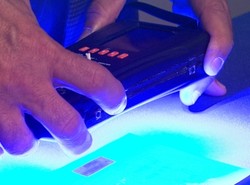USP starts field trials of FDA fake drug screening device
Phil Taylor, 06-Jun-2014
 The US Pharmacopeial Convention has started field testing a new low-cost screening device designed to detect counterfeit and poor quality medicines quickly.
The US Pharmacopeial Convention has started field testing a new low-cost screening device designed to detect counterfeit and poor quality medicines quickly.
The handheld CD-3+ unit - originally developed by the US Food and Drug Administration (FDA) - uses multiple light sources to look at packaging using different wavelengths and provide images that can be interpreted by the user to differentiate between genuine and falsified medicines. The approach may also be applicable to individual tablets.
USP and the Center for Pharmaceutical Advancement and Training (CePAT)- which was launched last year to equip national and local regulatory authorities in Sub-Saharan Africa with the knowledge and skills to promote access to quality medicines - will carry out the field trials.
The testing will take place in Ghana and will evaluate the FDA's device in the screening of two commonly-used malaria treatments - artemether plus lumefantrine (AR-LU) and artesunate plus amodiaquine (AS-AQ) - with the help of the country's Food and Drug Authority. Results from the first field study are expected in September 2014.
Prior testing
One researcher who already has hands-on experience with the CD-3+ device is Professor Paul Newton of the Centre for Tropical Medicine at Oxford University, who was given a unit to support his work assessing the quality of drugs for antimalarials and other medicines critical for public health in developing nations.
Newton told the recent Global Forum on Access to Safe Medicines conference in London that the device is an exciting tool for screening packaging and can be used effectively with only a basic level of training.
His team put the CD3+ through its paces in a small study which looked at 200 packs of the malaria drug artesunate, both genuine and falsified, which revealed that the unit was able to distinguish between them accurately in all but two cases.
The unit can test a sample in a few minutes and is much cheaper than rival devices that screen the chemical compositions of medicines, so could be a good option for cash-strapped regulatory agencies in the developing world.
The latest field testing is being conducted under an agreement between FDA and the US Agency for International Development (USAID), which funds the USP's Promoting the Quality of Medicines (PQM) programme.
Newton told the ASM that while the emergence of these handheld devices is encouraging, there is still a lack of information on their respective strengths and weaknesses.
"There needs to be more comparative studies conducted on their accuracy and how much training they need to be used effectively," he said.
To that end, the USP field trials will look at how the CD-3+ device slots into medicine screening alongside other devices, namely the Global Pharma Health Fund's Minilab kit and Thermo Scientific's hand-held Raman spectrometer TruScan unit.
"Field tests such as these will not only help us determine complementary advantages of the tools under evaluation, but will also help identify potential design improvements to CD-3+ to enable the development of a more robust, more portable and even easier to use tool," said Leigh Verbois, director of the Asia Pacific division of the Office of International Programmes at the FDA.
Newton would like to see the optical approach deployed in the CD-3+ combined with a chemical analysis device such as Raman, which would be particularly valuable as a front-line screening tool for the quality of medicines.
Related articles:

©
SecuringIndustry.com




 The US Pharmacopeial Convention has started field testing a new low-cost screening device designed to detect counterfeit and poor quality medicines quickly.
The US Pharmacopeial Convention has started field testing a new low-cost screening device designed to detect counterfeit and poor quality medicines quickly.